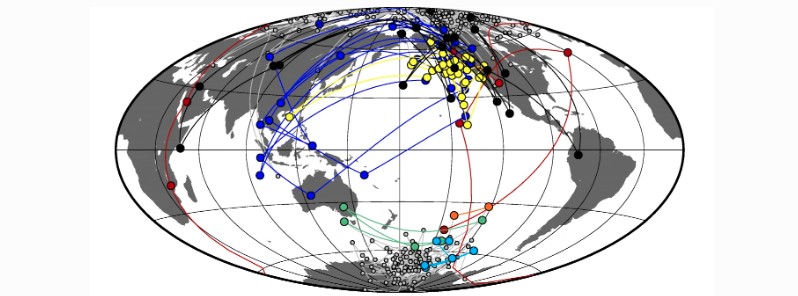Most detailed and complete record yet of Earth’s last magnetic reversal

A team of researchers from Japan made the most detailed and complete record to date of Earth's last magnetic reversal that took place about 773 000 years ago. Their results were published recently in the Progress in Earth and Planetary Science, a Springer journal.
Earth’s magnetic fields typically switch every 200 to 300 millennia, researchers said. Yet, the planet has remained steady for more than twice that now, with the last magnetic reversal occurring about 773 000 years ago.
Named for the geophysicists who discovered past geomagnetic reversals, the Matuyama-Brunhes geomagnetic reversal is one of the most studied paleomagnetic events, according to paper author Yuki Haneda, project researcher at the National Institute of Polar Research (NIPR) and a postdoctoral research fellow at the National Institute of Advanced Industrial Science and Technology (AIST) in Japan.
Such reversals swap the magnetic poles of the planet, which could have implications for plant and animal life. Such extrapolation to life, including humans and our ancestors, depends on the duration of the magnetic flip.
Previous studies by other researchers examined samples taken from lava flows, which offer a good snapshot of moments in geophysical history, but lava sequences cannot provide continuous paleomagnetic records due to the nature of sporadic eruptions, Haneda said.
"In this study, we collected new samples and conducted paleo- and rock-magnetic analyses of samples from the Chiba composite section, a continuous and expanded marine succession in Central Japan, to reconstruct the full sequence of the Matuyama-Brunhes geomagnetic reversal," Haneda said.
The Chiba composite section is widely considered to contain the most detailed marine sedimentary record of the Matuyama-Brunhes geomagnetic reversal, according to Haneda, and serves as the international standard for the lower boundary of the Middle Pleistocene Subseries and Chibanian Stage — when Homo sapiens emerged as a species.
The study found that the geomagnetic field became unstable at least 10 000 years prior to the magnetic direction change 773 000 years ago, and the full reversal process took at least 20 000 years.
"Our data is one of the most detailed paleomagnetic record during the Matuyama-Brunhes geomagnetic reversal, offering deep insight into the mechanism of the geomagnetic reversal," Haneda said.
The researchers said their next plan is to investigate how the geomagnetic reversal influenced plankton and plants, using marine microfossil and pollen data found in their samples.
Reference:
"A full sequence of the Matuyama–Brunhes geomagnetic reversal in the Chiba composite section, Central Japan" – Progress in Earth and Planetary Science – Haneda et al. – DOI: 10.1186/s40645-020-00354-y – OPEN ACCESS
Abstract
Geological records of the Matuyama–Brunhes (M–B) geomagnetic reversal facilitate the development of an age model for sedimentary and volcanic sequences and help decipher the dynamics of the Earth’s magnetic field. However, the structure of the geomagnetic field during the M–B geomagnetic reversal remains controversial due to its complex field behavior. In this study, we conducted paleo- and rock-magnetic analyses of samples from the Chiba composite section (CbCS), a continuous and expanded marine succession in Central Japan, to reconstruct the full sequence of the M–B geomagnetic reversal. We define an average stratigraphic position of the M–B boundary and estimate its age based on three sections in the CbCS and a neighboring drill core, TB-2. The average stratigraphic position of the M–B boundary in the CbCS is established at 1.1 ± 0.3 m above a widespread volcanic ash bed (the Byk-E tephra). Assuming a chronological error associated with orbital tuning of 5 kyr and stratigraphic uncertainty of 0.4 kyr, the M–B boundary in CbCS is at 772.9 ± 5.4 ka (1σ). The virtual geomagnetic pole, which is calculated from the paleomagnetic directions, shows several short fluctuations between 783 and 763 ka, with concomitant decreases in geomagnetic field intensity index. After termination of the field instabilities, the field intensity recovered and became higher than before the M–B boundary, with a stable normal polarity direction. The paleomagnetic records in the CbCS exhibit a field asymmetry between the axial dipole decay and field recovery, providing a full sequence of the M–B reversal, suggesting that the non-axial dipole field dominated several times during periods ca. 20 kyr long across the M–B boundary, due to depletion in the main axial dipole component. Our results provide probably the most detailed sedimentary record of the M–B geomagnetic reversal and offer valuable information to further understand the mechanism and dynamics of geomagnetic reversals.
Featured image credit: Haneda et al./Progress in Earth and Planetary Science

Commenting rules and guidelines
We value the thoughts and opinions of our readers and welcome healthy discussions on our website. In order to maintain a respectful and positive community, we ask that all commenters follow these rules.